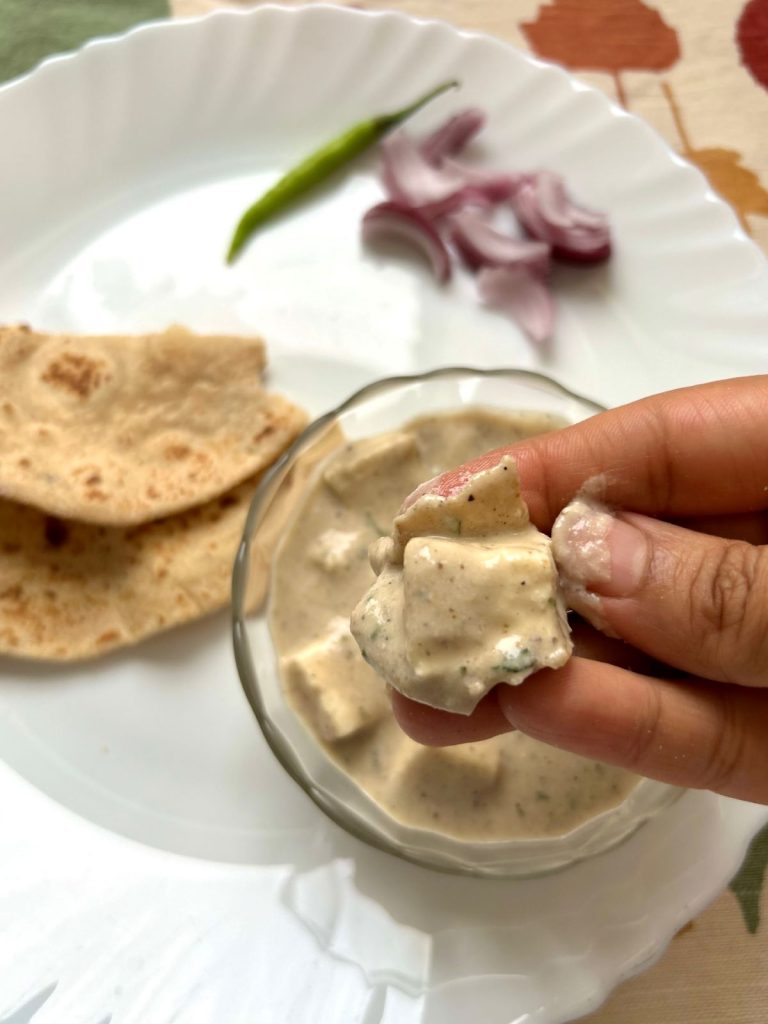
Paneer Kali Mirch is an onion based white gravy. The concept of combining the mild flavor of paneer with the strong flavour of black pepper emerged as Indian cookery developed, and regional cuisines grew in popularity. The flavours of this dish are mild yet there is subtle heat from the pepper. It has a rich silky-smooth gravy. As the name white gravy suggests, we instantly associate white gravy with too much cream but surprisingly this kali mirch gravy does not contain any cream at all. The gravy is made using cashews and milk which makes it light and easy on your stomach. It is perfect for those days when strong paneer cravings strike but you don’t want to indulge in those heavily cream based gravies. It can turn your boring lunch or dinner to something special, something that will bring a sense of satisfaction and smile to your face. I promise that! 🙂

I had my first kali mirch paneer dish from a famous restaurant in Ludhiana, a city in Punjab. I loved it so much then that I badly wanted to crack the recipe. Lot of trials later, I kind of figured out the technique they use but I wish I can crack the recipe of their secret masala. Though, this recipe doesn’t give that exact taste but comes pretty close to the original and of course tastes delicious.
For people who eat chicken and want to make Kali Mirch Chicken, you can totally use this recipe. Just marinate chicken in ginger-garlic paste, salt and black pepper for 30 minutes to an hour before and cook it in the gravy.
Now let’s see how we can make this delicious paneer dish. Check out the step by step recipe below.

Recipe: serves 3
Ingredients: cup measurement 250 ml
- Paneer: 200 grams
- Black pepper: 1 tbsp (freshly ground)
For the Gravy
- Onion: 1 large or 2 medium, sliced
- Ginger: 1 inch
- Garlic: 7-8 cloves
- Green Chilli: 1
- Oil: 2 tbsps
- Ghee: 2 tbsps
- Milk: 1.5 cups
- Cashews: 8-9
- Water: 1/2 cup or as required
- Kasuri Methi: 1 tsp
- Bay leaf: 1
- Salt to taste
For Kali Mirch Paneer Masala
- Cloves: 2
- Black Cardamom: 1
- Green Cardamom: 2
- Mace: 1
- Cumin seeds: 1/4th tsp
- Coriander seeds: 1.5 tbsp
- Cinnamon stick: 1/2 an inch
Instructions
- In a wok roast all the dry spices till they become fragrant and coriander seeds turn slightly brown. Then ground them in the mixer grinder or mortar pestle to a fine powder. Keep aside.

- In the same wok heat oil and ghee. Add bay leaf, roughly chopped ginger and garlic. Slit the green chilli from the middle and then add it. Sauté till they the rawness goes. Do not brown it.
- Now, add sliced onions, some salt and cook till they become translucent. Add cashews and sauté till onions become soft. Do not brown the onions. We need white gravy. Browning onions will change the colour and flavour of the gravy.

- Once the onions become soft, switch off the flame. Remove green chilli and bay leaf. Allow onions to cool a little then transfer to a mixer jar. Add a little water and blend to a smooth paste.

- Transfer the paste back to the wok. Add 2 tbsps of prepared masala and 1/2 tsp of freshly ground black pepper. Mix well. Cook the onion paste for 4 to 5 minutes on low flame.

- Now add 1.5 cups of milk in the wok. Swirl some milk in the mixer jar to take out all the onion paste. Bring the milk to simmer then immediately lower the flame. Do not boil the milk on high heat. Chances are that it will curdle. Keep stirring regularly for 5-6 minutes so that milk doesn’t curdle. This is the only tricky part. Rest is a cake walk.

- Once the gravy starts to thicken, add 1/2 cup of water, salt to taste and cook on low flame till the gravy thickens and coats the back of the spoon.
- Now crush kasuri methi between your hands and add it to the gravy along with remaining black pepper. Mix well.

- Add diced paneer cubes to the gravy and 1 tbsp of prepared masala. Cook on low flame for another 5 minutes. After 3 or 4 minutes, check for salt, add if required, cook for another minute and switch off the flame.

- Cover and let the gravy rest for 10 to 15 minutes before serving. Serve with hot rotis, naan or paranthas.
Troubleshooting
- The only trouble shooting in this recipe is curdling of the milk. If that happens, don’t get worried, I have got you covered. If the milk curdles while the gravy is thickening, then let the gravy thicken at first. Once it thickens, switch off the flame. Allow it to cool a little. Now before adding water, blend the curdled gravy in the blender and you will get a silky-smooth gravy. Transfer the gravy back to the wok, add water and cook like mentioned above.
Pro tips:
- For the best flavor and aroma, use peppercorns that are no more than a year old and grind them fresh using a pepper grinder or mortar pestle.
- The gravy can be made a day or two ahead and refrigerated. When ready to serve, add the paneer, cook for 5 minutes and serve. You can add some water to loosen up the gravy.
- If you want to make even more lighter gravy, you can skip cashews and just use milk.
Once you try this paneer kali mirch, I am sure it’ll become a regular part of your meal rotation. Do let me know in the comments how this recipe turned out for you. I would love to have your feedback. Stay Healthy! 🙂













